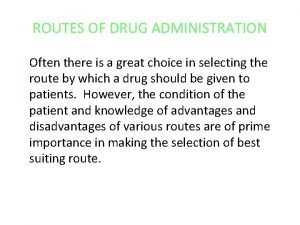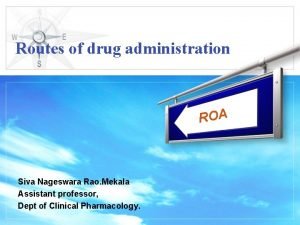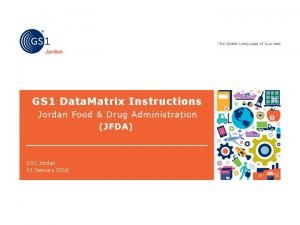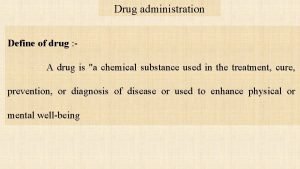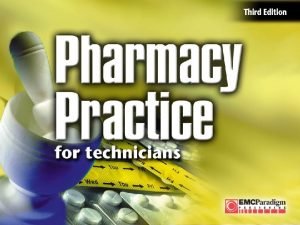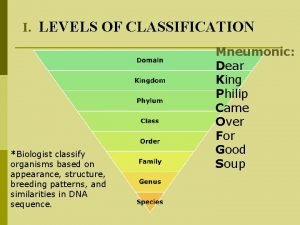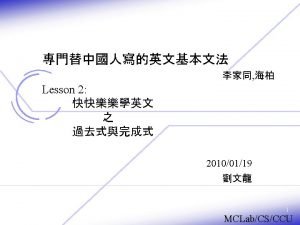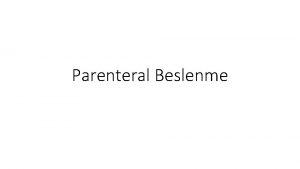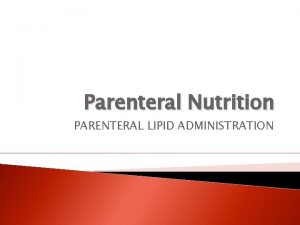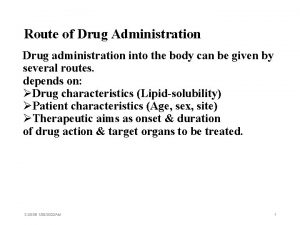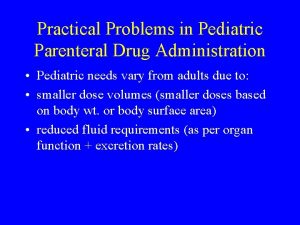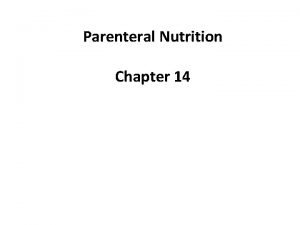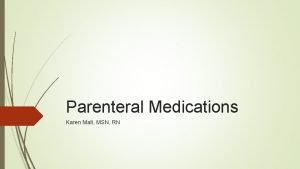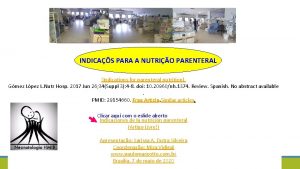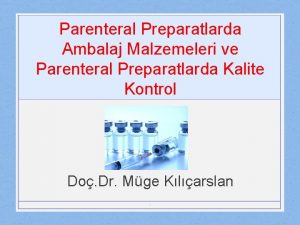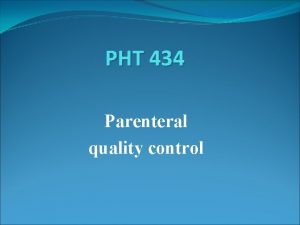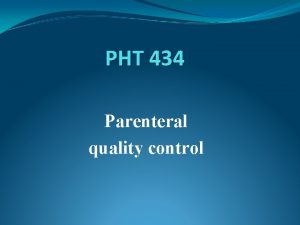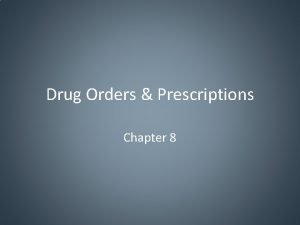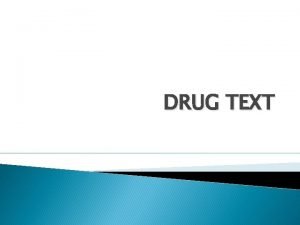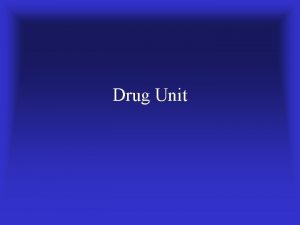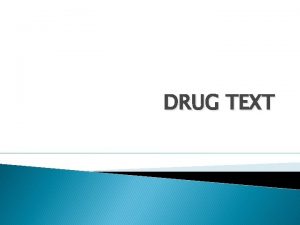Parenteral Drug Administration Parenteral Administration Parenteral came from































































- Slides: 63

Parenteral Drug Administration

Parenteral Administration • Parenteral – came from the Greek words “para enteron” meaning “to avoid the intestine. ” Includes in its broadest sense, any drug (or fluid) whose delivery does not utilize the alimentary canal for entry into body tissues.

Parenteral Administration 1. Intradermal Administration Action / Purpose • Local Effect • A small amount is injected so that volume does not interfere with wheal formation or cause a systemic reaction • Used for observation of an inflammatory (allergic) reaction to foreign proteins. Ex: tuberculin testing for drug and other allergic sensitivities some immunotherapy for cancer.

Parenteral Administration Intradermal Sites • Locations are chosen so that an inflammatory reaction can be observed. Preferred areas: – lightly pigmented – thinly keratinized – hairless • ventral mid forearm • clavicular area of the chest • scapular areas of the back

Parenteral Administration Intradermal Injection Sites • Clavicular Area Scapular Area Ventral Mid Forearm

Parenteral Administration Skin Layers - Injection Site Epidermis Layer Dermis Layer Subcutaneous Layer Muscle Layer

Parenteral Administration Intradermal Equipment • Needle: 26 to 27 gauge • Syringe: • 1 ml calibrated in 0. 01 ml increments (usually 0. 01 to 0. 1 ml injected)

Parenteral Administration Intradermal Technique: • Cleanse the area using a circular motion; observe sterile technique • Hold the skin taut • Insert the needle, bevel up, at a 10 to 15 degree angle; the outline of the needle under the skin should be visible.

Parenteral Administration Intradermal Technique • Inject the medication slowly to form a wheal (blister or bleb) • Remove the needle slowly; do not recap

Parenteral Administration Intradermal Technique • Do not massage the area; also instruct the client not to do so • Mark the area with a pen, and ask the client not to wash it off until read by a health care provider

Parenteral Administration Intradermal Technique • Assess for allergic reaction in 24 – 72 hours; measure the diameter of local reaction. For tuberculin, measure only the indurated area; do not include redness in the measurement

Parenteral Administration 2. Subcutaneous Injection Definition • a small thin needle is inserted beneath the skin and the drug injected slowly. • The drug moves from the small blood vessels into the bloodstream. • Usually slower in onset than with the IM route Purpose • It is done when a small amount of fluid is to be injected, the patient is unable to take the drug orally, or the drug is destroyed by intestinal secretions

Parenteral Administration Site for injection 1. 2. 3. 4. 5. Abdomen Upper hips Upper back Lateral upper arms Lateral thighs Note: § Stay 1 inch away from the last injection. § Stay 2 inches away from your navel or scars. § Do not use areas that are bruised, tender or swollen. § The injection site should always be rotated so that consecutive injections are never given into the same area

Parenteral Administration Equipment Needed 1. 2. 3. 4. Needle – 25 to 27 gauge, ½ to 5/8 inches in length Syringe – 1 to 3 m. L 2 alcohol wipes Insulin syringe (for insulin use only)

Parenteral Administration Technique 1. Wash and dry your hands 2. Prepare the medicine to be administered

Parenteral Administration 3. Clean your skin with an alcohol pad. Start at the proposed site then wipe in a circular motion, moving outward with each circle to prepare an area 2 -3 inches in diameter around the injection site. Let the alcohol air dry. 4. Gently pinch the skin at the injection site. Insert the needle through the skin at a 45 to 90 degrees angle so that the tip of the needle is under the skin and above the muscle layer.

Parenteral Administration 5. Release the skin and gently pull back on the plunger to make sure the tip of the needle is not in a blood vessel. Note: DO NOT aspirate when using Heparin 6. Slowly inject the medication. When all the medication is injected, pull the needle out and quickly press the alcohol wipes onto the site for 30 to 60 seconds. Do not rub the skin.

Parenteral Administration 7. Discard the syringe and attached needle into your puncture proof Sharps container. Do not recap the needle. 8. Wash and dry your hands

Parenteral Administration 3. Intramuscular Injection Definition • An intramuscular (IM) injection is a shot where the needle goes into the muscle layer under the skin in order to deliver medicine. • Usually more rapid effect of drug than with sub. Q route • Used for irritating drugs, aqueous suspensions, and solutions in oils.

Parenteral Administration Purpose • IM injections are also used to deliver medications that would otherwise be absorbed too slowly or made ineffective if taken by mouth. Examples of such medications include: • • Certain antibiotics Certain contraceptive hormones Most vaccines Epinephrine injections for people with severe allergic reactions

Parenteral Administration Site for injection 1. Ventrogluteal Client Position: SUPINE LATERAL Note: § Suited for deep IM or Z-track injection

Parenteral Administration Site for injection 2. Dorsogluteal Client Position: PRONE Note: § Suited for deep IM or Z-track injection § Requires accurate site and technique

Parenteral Administration Site for injection 3. Deltoid Client Position: LATERAL, PRONE, SITTING, SUPINE Note: § Readily accesible § Close to nerves

Parenteral Administration Site for injection 4. Vastus Lateralis Client Position: SITTING, SUPINE Note: § Good site for infants § Free of major nerves

Parenteral Administration Equipment Needed • Needle: 20 -23 gauge, 18 gauge for blood products; 1 -1. 5 inches in length • Syringe: 1 to 3 ml (usually 0. 5 to 1. 5 ml injected)

Parenteral Administration Technique • Same as sub. Q • Insert needle 90° into the muscles

Parenteral Administration Technique Note: § Prepare all equipment § Use dart or pencil hold § If blood is present during aspiration, DO NOT INJECT.

Parenteral Administration Technique Note: § Break through the skin quickly to minimize pain § Don’t change the direction of the needle as it goes in or comes out § Do not reuse disposable needles

Parenteral Administration Z-track Technique • Prevents the medication from leaking back or entering into the sub. Q tissue. Note: Gluteal site is preferred

Parenteral Administration 4. INTRAVENOUS ADMINISTRATION OF MEDICATION

Medications are Administered Intravenously by the following methods: a. ) Large volume infusion of intravenous fluid q Mixing a medication into a large-volume IV container. q Drugs are diluted in volumes of 1000 ml or 500 ml of compatible fluids. Fluids such as IV normal saline or Ringer’s lactate are frequently used. q Commonly added drugs are Potassium Chloride and Vitamins. q The medication can be added to the fluid container that is running or before it is hung and infusing.

Procedure: 1. Wash hands and observe other appropriate infection control procedure. 2. Prepare medication ampule or vial for drug withdrawal. 3. Add the medication. To new IV container: Ø Locate the injection port and carefully remove its cover. Clean the port with antiseptic or alcohol swab. Ø Remove the needle cap from the syringe, insert the needle through the center of injection port, and inject the medication into the bag or bottle. Ø Mix the medication and solution by gently rotating the bag or bottle.

Parenteral Administration Adding medications to Intravenous Fluid Container Equipment: • MAR or computer form • Correct medication • Diluent for medication in powdered form • Correct solution container, if a new one is to be attached • Antiseptic or alcohol swabs • Sterile syringes of appropriate size • IV additive label

ØComplete the IV additive label with name and dose of medication, date, time, and nurse’s initials. Attached it upside down on the bag or bottle. ØClamp the IV tubing. Spike the bag or bottle with IV tubing and hang the IV. ØRegulate infusion rate as ordered. ØTo an existing Infusion: ØDetermine that the IV solution in the container is sufficient for adding the medication. ØConfirm the desired dilution of the medication, that is, the amount of medication per milliliter of solution

Parenteral Administration Ø Closed the infusion clamp. Ø Wipe the medication port with the alcohol swab. Ø Remove the needle cover from the medication syringe. Ø While supporting and stabilizing the bag, carefully insert the syringe needle thorough the port and inject the medication Ø Remove the bag or bottle from the pole and gently rotate the bottle or bag. Ø Re-hang the container and regulate IV flow.

4. Dispose of the equipment and supplies according to agency policies/practice. 5. Document the medication in the appropriate form in the client’s record.

Parenteral Administration b. ) Intermittent intravenous infusion (piggyback or tandem setups) q Methods of administering a medication mixed in a small amount of IV solution, such as 50 or 100 ml. q The drugs are administered at a regular intervals, such as every 4 hrs, with the drug being infused for a short period of time such as 30 to 60 minutes

Parenteral Administration q Two commonly used additive or secondary IV setups are the tandem and the piggy back. q Traditionally the tubing of the secondary set has been attached to the ports of the primary infusion by inserting needle through port and taping it in place. Tandem setups – a second container is attached to the line of the first container at thelower, secondary port. It permits medications to be administered intermittently or simultaneously with the primary solution.

Piggyback – a second set connects the second container to the tubing of the primary container at the upper port. This setup is used solely for intermittent drug administration.

Parenteral Administration c. ) Volume controlled infusion( often used for children) q q Intermittent medications may also be administered by volume controlled infusion set such as Buretrol, Soluset, Volutrol, and Pediatrol. They are small fluid containers (100 -150 ml in size) attached below the primary infusion container so that the medication is administered through the clients IV line. Volume control sets are frequently used to infuse solutions into children and older clients when the volume administered is critical and must be carefully monitored.

Adding Medication to a Volume-Control Infusion Set Equipment: • Medication in a vial or ampule • Sterile syringe • Antiseptic or alcohol swab Procedure: 1. Withdraw the required dose of the medication into a syringe. 2. Ensure that there is sufficient fluid in the volumecontrol fluid chamber to dilute the medication. Generally, at least 50 ml of fluid is used.

3. Close the inflow to the fluid chamber by adjusting the upper roller or slide clamp above the fluid chamber; also ensure that the clamp on the air vent of the chamber is open. 4. Clean the medication port on the volumecontrol fluid chamber with an alcohol swab. 5. Inject the medication into the port of the partially filled volume control set. 6. Gently rotate the fluid chamber until the fluid is well mixed. 7. Open the line’s upper clamp, and regulate the flow by adjusting the lower roller or slide clamp below the fluid chamber. 8. Attach a medication label to the volume-control fluid chamber. 9. Document relevant data, and monitor the client and the infusion.


Parenteral Administration d. ) IV push or bolus q IV push or bolus is the intravenous administration of an undiluted drug directly into the systemic circulation. q It is used when a medication cannot be diluted or in an emergency. q An IV bolus can be introduced directly into the vein by venipuncture or into an existing IV line through an injection port or through an IV lock.

Parenteral Administration Administering Intravenous Medications Using IV Push Equipment: For IV push for an existing line: • Medication in a vial or ampule • Sterile syringe • Sterile needles • Antiseptic swab

Parenteral Administration For IV push for an IV lock • Medication in a vial or ampule • Sterile syringe (3 or 5 ml, to prepare medication) • Sterile syringe (3 ml, for saline or heparin flush) • Vial of normal saline to flush the IV catheter or vial of heparin flush or both • Sterile needles • Antiseptic swab • Disposable gloves

Procedure: 1. Wash hands and observe other appropriate infection control procedures. 2. Prepare the medication. • Existing IV line: Ø Prepare the medication according to the manufacturer’s direction. • IV lock: Ø Flushing with saline – prepare two syringes, each with 1 ml of sterile normal saline. Ø Flushing with heparin and saline – prepare one syringe with 1 ml heparin flush solution, prepare two syringes with 1 ml each of sterile, normal saline, and draw up the medication into a syringe.

3. Put a small-gauge needle on the syringe if using a needle system. 4. Wash hand put clean gloves. 5. Provide client privacy. 6. Prepare the client. 7. Explain the purpose of the medication and how it will help, using language that the client can understand. Include relevant information about the effects of the medication. 8. Administer the medication by IV push. For existing IV line: Ø Identify the injection port closest to the client. Ø Clean the port with alcohol swab. Ø Stop the IV flow by closing clamp or pinching the tubing above the injection port.

Parenteral Administration Ø Insert the needle of the syringe that contains the medication through the center of the port. Ø Pull back plunger of the syringe in order to aspirate a small amount of blood. Ø After observing the blood, continue to keep the clamp closed and inject the medication at the ordered rate. Ø Release the clamp or tubing. Ø After injecting the medication withdraw the needle.

For IV lock: Ø Clean the diaphragm with antiseptic swab. Ø Insert the needle of the syringe containing normal saline through the center of the diaphragm and aspirate for blood. Ø Flush the lock by injecting 1 ml of saline slowly. Ø Remove the needle and syringe. Ø Clean the lock’s diaphragm with an anti septic swab. Ø Insert the needles of the syringe containing the prepared medication through the center of the diaphragm. Ø Inject the medication slowly at the recommended rate of infusion. Ø Withdraw the needle and syringe. Ø Clean the diaphragm of the lock.

Ø Attach the second saline syringe and inject 1 ml of saline. Ø If heparin is used, inert the heparin syringe and inject the heparin slowly into the lock. 9. Dispose of equipment according to agency practice. 10. Remove and dispose of gloves. Wash hands. 11. Observe the client closely for adverse reactions. 12. Determine agency practice about recommended times for changing the IV lock. 13. Document.

Parenteral Administration

e. ) Intermittent infusion ports q Maybe affixed to an intravenous catheter or needle to allow medications to be administered intravenously without requiring repeated needle sticks or a continuous intravenous infusion. q Intermittent injection ports have either a resealable latex injection site for needle access or a port that allows a syringe or a needle less adapter to be connected for administering medications. q Intermittent injection ports may be flushed with the sterile saline prior to medication administration, and with saline or heparinized saline afterward. (flushing the port maintains the patency of the intravenous catheter and port, and reduce the risks of mixing incompatible medications within the system)

Parenteral Administration 5. Total Parenteral Nutrition Definition • TPN, total parenteral nutrition, or "hyperal" is the special IV solution of nutrients (calories, fat, and protein) into the blood stream through an IV • It is used in cases of long-term coma, severe burns or severe gastrointestinal syndromes Purpose/Why it is necessary • is used for patients who cannot or should not get their nutrition through eating. Site for injection • It is given through an IV placed in the arm, groin, neck, or chest and any central vein.

Parenteral Administration Equipment Needed • IV Catheter or medical infusion pump • Sterile bag of nutrient solution

Parenteral Administration Technique • A local anaesthetic is used to numb the area. • A tube or "catheter" is normally inserted into a large vein, such as the one situated under the collarbone. • A nutritious solution is fed through the catheter into the veins. The feeding each day will take several hours. TPN provides: – – – Carbohydrates in the form of glucose. Protein in the form of amino acids. Lipids in the form of triglycerides. Electrolytes. Vitamins and trace minerals.

Parenteral Administration 4. Epidural Injection Definition • An epidural injection places anti-inflammatory medicine into the epidural space. Purpose • It is used to treat swelling, pain, and inflammation associated with neurological conditions that affect nerve roots. • Also used to administer anaesthesia for pain relief in labor.

Parenteral Administration Site of injection • The membrane that covers the spinal cord and nerve roots in the spine is called the dura membrane. The space surrounding the dura is the epidural space.

Parenteral Administration Site of injection

Parenteral Administration Equipment needed • Epidural needle – 18 gauge • Syringes • Aniseptic – Betadine • Epidural catheter • Fluoroscope

Fluoroscope

Types of Epidural Injection • Needle through Needle • Epidural Catheter

Parenteral Administration Technique 1. The patient is positioned, either lying down or sitting up, in a hunched posture to flex the spine. By palpating the bony protrusion area, the midpoint of the chosen interspace is found and marked. 2. Once the correct entry point has been marked and standard sterility and procedures has been completed, an epidural needle is advanced through the skin and tissues.
 Non parenteral
Non parenteral Instead of the cross the albatross alliteration
Instead of the cross the albatross alliteration Example of crude drug adulterated with exhausted drug
Example of crude drug adulterated with exhausted drug Penrose drain
Penrose drain Factors affecting choice of route of drug administration
Factors affecting choice of route of drug administration What is pharmacology
What is pharmacology Intradermal drug administration
Intradermal drug administration Drug roa
Drug roa What are the different routes of drug administration
What are the different routes of drug administration Jordan food and drug administration
Jordan food and drug administration Intrademal
Intrademal Angesid
Angesid Parenteral route
Parenteral route What came down the chimney in freak the mighty
What came down the chimney in freak the mighty Childe roland summary
Childe roland summary Bunny hopping through the forest
Bunny hopping through the forest When i first came to this land i was not a wealthy man
When i first came to this land i was not a wealthy man Dear king phillip came over for good spaghetti
Dear king phillip came over for good spaghetti They looked like frightened beads
They looked like frightened beads Where did the vikings originate from
Where did the vikings originate from Dear king philip came over for good soup
Dear king philip came over for good soup Your bff is going to a party this weekend
Your bff is going to a party this weekend What are the kingdoms in biology
What are the kingdoms in biology My breakfast is
My breakfast is She came down
She came down What came first the chicken or the egg
What came first the chicken or the egg The student sitting next to you just came
The student sitting next to you just came Holocaust
Holocaust Coined the word photography
Coined the word photography The man wasn't friendly. i spoke to him yesterday
The man wasn't friendly. i spoke to him yesterday King phillip came over for good spaghetti
King phillip came over for good spaghetti When mr pirzada came to dine analysis
When mr pirzada came to dine analysis Computer word came from
Computer word came from .... to school yesterday
.... to school yesterday Write a short note on the national archives of india
Write a short note on the national archives of india We are glad you came
We are glad you came What is the theme of first they came for the communists
What is the theme of first they came for the communists For the thief comes to kill
For the thief comes to kill A woman came out of her house and saw
A woman came out of her house and saw Past simple infinitive examples
Past simple infinitive examples Then came the wave atoma
Then came the wave atoma How muslim came to india
How muslim came to india The day came slow till five o'clock analysis
The day came slow till five o'clock analysis Benefits of prokaryotes
Benefits of prokaryotes First they came for
First they came for Were glad you came
Were glad you came Dear king phillip came over
Dear king phillip came over Tabula rasa skinner
Tabula rasa skinner A dichotomous key is used to
A dichotomous key is used to King phillip came over for good soup
King phillip came over for good soup What is one reason colonists came to america?
What is one reason colonists came to america? Mud bbs
Mud bbs Read ready
Read ready Hugh hefner
Hugh hefner Dear king phillip came over
Dear king phillip came over Canon came from the greek word
Canon came from the greek word Iemanja brown
Iemanja brown What's the dewey decimal system
What's the dewey decimal system The day the dancers came
The day the dancers came When god almighty came to be one of us
When god almighty came to be one of us When british came to india
When british came to india The image
The image Goldilocks was very tired now en español
Goldilocks was very tired now en español Technology came from the two greek word, *
Technology came from the two greek word, *






